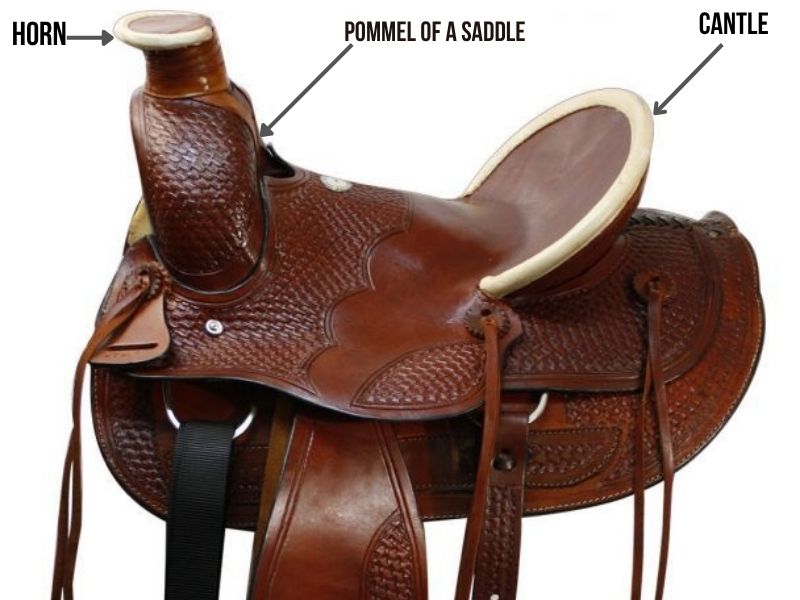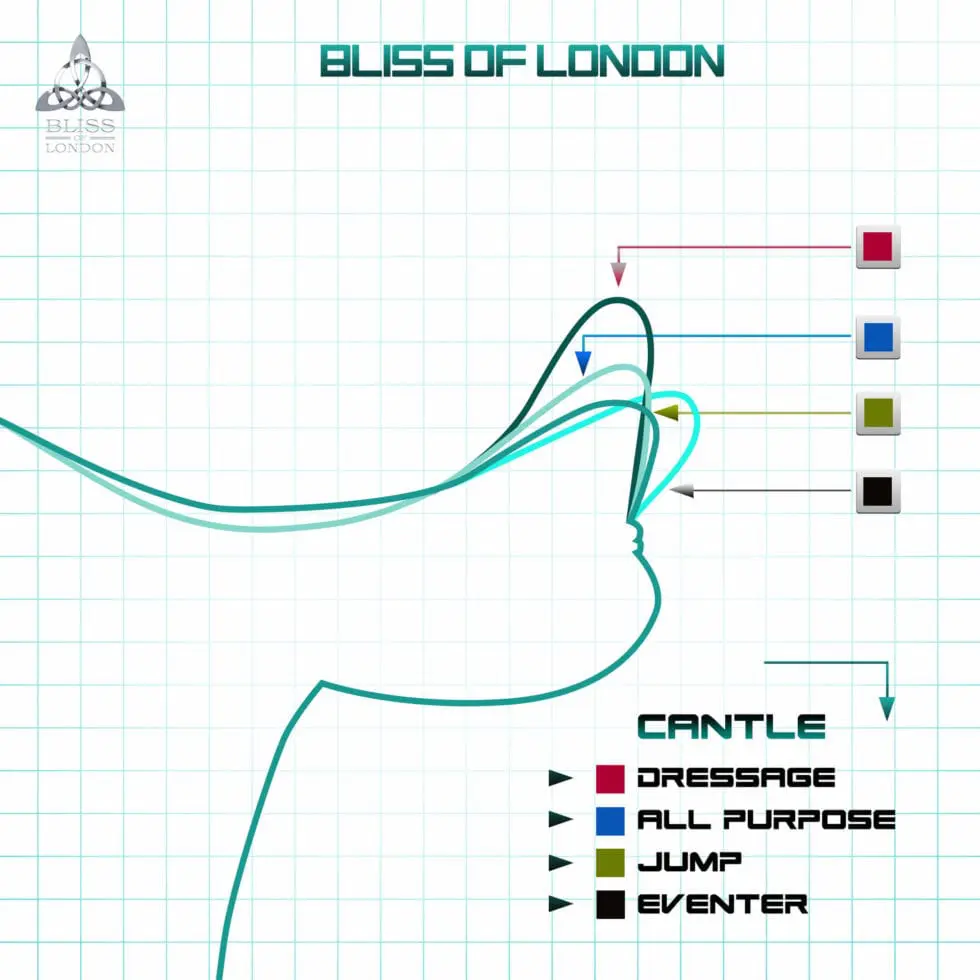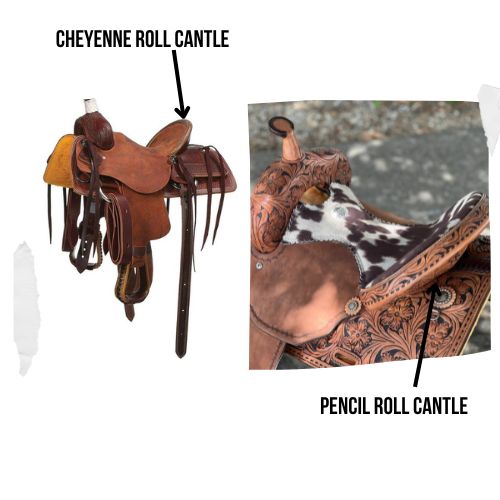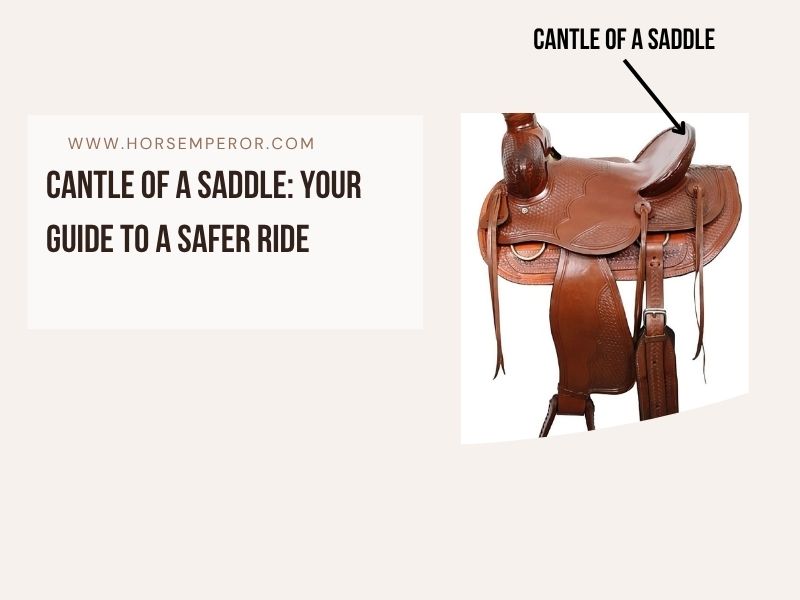The cantle is the back part of the saddle seat, which works as a backrest to provide support and stability to the rider. It also plays an important role in anchoring the bars of the saddle tree so that the saddle stays balanced and functional.
In every saddle, the cantle’s heights, angles, and shapes are designed differently, but its role is the same—to give comfort, balance, and security to the riders.
Many riders get confused between the cantle and the pommel. The cantle is the raised back part of the saddle that provides support to the rider, and the pommel is the raised front part of the saddle with a medium or steep slope near the horse’s withers.
This article covers everything about the cantle—from its purpose and types to its maintenance and measurement—so after reading, you can make your saddle seat more comfortable and secure.
What Is the Cantle?
The cantle is the highest part of the saddle that sits at the rear end of the saddle. The pommel or swell is found at the front, on top of the horse’s wither, while the cantle is located at the back, on top of the saddle.
Located at the back of the seat, the cantle acts as a backrest, providing support and strength to the rider’s back. Its role in anchoring the bars of the saddle tree helps the saddle maintain balance and function.
A well-designed cantle allows the rider to stay stable in the saddle without struggling to remain centered.

Where Is the Cantle Located?
The cantle is found behind the seat at the top of the horse’s back. To make the saddle more secure, it forms the raised back edge in Western saddles. The height and slope of the cantle depend on the riding discipline in English saddles.
But whether it’s a Western or English saddle, the main purpose of the cantle is to provide support and security to the rider. It’s easy to remember that in every saddle, the cantle is found opposite the pommel or swell.
Purpose of the Cantle
During fast and unpredictable movements, the cantle plays a key role in keeping a rider secure in the saddle. Its raised back edge works with the seat design to maintain posture and prevent the rider from slipping onto the horse’s back.
It is found with a saddle horn in Western saddles, which gives extra support to the rider. It also helps in anchoring the rider’s legs in the right position, which is why a Western saddle with a high cantle is more suitable for young or new riders than a low cantle English saddle.
The safety and comfort of the saddle depend on the slope and height of the cantle. A medium slope or steep slope cantle is best for riding, while a cantle over 5.5 inches is risky for riders because if a rider loses control, they could land painfully on a too-high cantle.

Dressage saddles come with a deep seat and higher cantle because they give close contact and stability, while jumping saddles have a flat seat and lower cantle, which provides more freedom to move.
The cantle supports the rider’s back and prevents them from sliding backward. Whether it’s trail riding, ranch work, dressage, or jumping, the cantle plays a role in keeping you steady.
- For trail riding and ranch work, Western saddles come with a high cantle that offers more safety and stability.
- English saddles for dressage have a high cantle and deep seat, which provide a close, stable feel.
- Jumping saddles come with a lower cantle and flatter seat, which are best for moving over fences.
Types, Styles & Design Features of a Cantle
Height, angle, and style of cantles play a vital role in rider comfort, stability, and performance. By understanding the use of each saddle style, you can choose the best saddle that suits your discipline and riding style.
Cantle Height
The height of the cantle is crucial for rider protection and posture.
- Due to their stability, high cantles are best for disciplines like barrel racing, trail riding, and ranch work. They also give extra back support, security, and posture control.
- For Western disciplines like cutting and reining, low cantles provide more freedom of movement.
Finding the right height depends on your riding needs, as many riders use medium-height cantles, which are more comfortable for everyday use.
Cantle Angle
Similar to height, choosing the right angle of the cantle gives both comfort and security.
- Straighter cantle angles are mostly found in ranch saddles, trail saddles, and work saddles because they give a deeper and more secure seat.
- Medium-sloped cantles are most common because they provide a balance of comfort and stability for various disciplines.
- Tipped cantles are often used for tasks that require upper body mobility, such as reining and roping, because they prevent the cantle from getting in the way during quick, controlled movements.
Cantle Styles

There are two main designs found in cantle styles:
- Pencil Roll Cantle – A smooth, rounded, clean-look cantle with minimal ledge. It is a favorite for riders who like a sleek design over extra grip.
- Cheyenne Roll Cantle – Features a small stabilizing ledge that gives the rider extra grip during sudden movements. Due to its security and comfort, it is a popular choice for various riding disciplines.
Whether you choose a high, straight Cheyenne roll for ranch work or a low, tipped pencil roll for reining, the cantle’s design should match your discipline, comfort preference, and safety needs.
How to Measure the Cantle
Measuring your cantle helps you understand your saddle’s fit and style:
- Place a straight edge across the deepest part of the seat.
- Using a retractable ruler, measure from that point up to the top rear edge of the cantle.
- Note the measurement and compare it to the saddle’s intended use.
Maintenance & Care Tips
Keeping your cantle in good condition ensures both safety and comfort:
- Check saddle fit regularly—an imbalance between the pommel and cantle can cause discomfort for both horse and rider.
- Inspect stitching and leather around the cantle; any weakness can lead to accidents.
- Re-flock or repair every 2 years, or as needed, to maintain proper balance and support.
Cantle Impact on Saddle Fit & Performance
The cantle works together with the pommel to keep the saddle balanced. If one is higher or lower than intended, it can:
- Affect the rider’s posture.
- Reduce control.
- Cause pressure points on the horse’s back.
A higher cantle can help you feel more secure but may restrict movement, while a lower cantle offers freedom but less back support.
Cantle by Saddle Type
| Saddle Type | Cantle Characteristics | Best For |
|---|---|---|
| Western (Trail/Ranch) | High, straight or medium slope | Security, long rides |
| Western (Cutting/Reining) | Lower, steeper angle | Agility, quick movements |
| English Dressage | Higher cantle, deep seat | Stability, close contact |
| English Jumping | Lower, flatter cantle | Freedom of movement |
